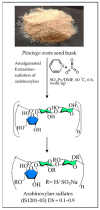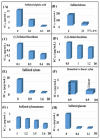Antiviral Strategies Using Natural Source-Derived Sulfated Polysaccharides in the Light of the COVID-19 Pandemic and Major Human Pathogenic Viruses
- PMID: 35062238
- PMCID: PMC8781365
- DOI: 10.3390/v14010035
Antiviral Strategies Using Natural Source-Derived Sulfated Polysaccharides in the Light of the COVID-19 Pandemic and Major Human Pathogenic Viruses
Abstract
Only a mere fraction of the huge variety of human pathogenic viruses can be targeted by the currently available spectrum of antiviral drugs. The severe acute respiratory syndrome coronavirus 2 (SARS-CoV-2) outbreak has highlighted the urgent need for molecules that can be deployed quickly to treat novel, developing or re-emerging viral infections. Sulfated polysaccharides are found on the surfaces of both the susceptible host cells and the majority of human viruses, and thus can play an important role during viral infection. Such polysaccharides widely occurring in natural sources, specifically those converted into sulfated varieties, have already proved to possess a high level and sometimes also broad-spectrum antiviral activity. This antiviral potency can be determined through multifold molecular pathways, which in many cases have low profiles of cytotoxicity. Consequently, several new polysaccharide-derived drugs are currently being investigated in clinical settings. We reviewed the present status of research on sulfated polysaccharide-based antiviral agents, their structural characteristics, structure-activity relationships, and the potential of clinical application. Furthermore, the molecular mechanisms of sulfated polysaccharides involved in viral infection or in antiviral activity, respectively, are discussed, together with a focus on the emerging methodology contributing to polysaccharide-based drug development.
Keywords: antiviral activities and mechanisms; antiviral efficacy; drug structure-activity relationship; emerging viral infections; heparin mimetics; in vivo studies; major human pathogenic viruses; sulfated polysaccharides; virus entry as a target.
Conflict of interest statement
The authors declare no conflict of interest.
Figures




Similar articles
-
Recent advances in antiviral activities and potential mechanisms of sulfated polysaccharides.Carbohydr Polym. 2021 Nov 15;272:118526. doi: 10.1016/j.carbpol.2021.118526. Epub 2021 Aug 5. Carbohydr Polym. 2021. PMID: 34420760 Review.
-
Effective Inhibition of SARS-CoV-2 Entry by Heparin and Enoxaparin Derivatives.J Virol. 2021 Jan 13;95(3):e01987-20. doi: 10.1128/JVI.01987-20. Print 2021 Jan 13. J Virol. 2021. PMID: 33173010 Free PMC article.
-
Marine sulfated polysaccharides as potential antiviral drug candidates to treat Corona Virus disease (COVID-19).Carbohydr Res. 2021 Jul;505:108326. doi: 10.1016/j.carres.2021.108326. Epub 2021 May 3. Carbohydr Res. 2021. PMID: 34015720 Free PMC article. Review.
-
Marine Sulfated Polysaccharides as Promising Antiviral Agents: A Comprehensive Report and Modeling Study Focusing on SARS CoV-2.Mar Drugs. 2021 Jul 22;19(8):406. doi: 10.3390/md19080406. Mar Drugs. 2021. PMID: 34436245 Free PMC article.
-
Chemically sulfated polysaccharides from natural sources: Assessment of extraction-sulfation efficiencies, structural features and antiviral activities.Int J Biol Macromol. 2019 Sep 1;136:521-530. doi: 10.1016/j.ijbiomac.2019.05.005. Epub 2019 May 31. Int J Biol Macromol. 2019. PMID: 31158418
Cited by
-
Candida albicans as a Trailblazer for Herpes Simplex Virus-2 Infection Against an In Vitro Reconstituted Human Vaginal Epithelium.Microorganisms. 2025 Apr 14;13(4):905. doi: 10.3390/microorganisms13040905. Microorganisms. 2025. PMID: 40284741 Free PMC article.
-
Characterization and optimization of exopolysaccharide extracted from a newly isolated halotolerant cyanobacterium, Acaryochloris Al-Azhar MNE ON864448.1 with antiviral activity.Microb Cell Fact. 2024 Apr 22;23(1):117. doi: 10.1186/s12934-024-02383-4. Microb Cell Fact. 2024. PMID: 38644470 Free PMC article.
-
Gene Set Enrichment Analysis Reveals That Fucoidan Induces Type I IFN Pathways in BMDC.Nutrients. 2022 May 27;14(11):2242. doi: 10.3390/nu14112242. Nutrients. 2022. PMID: 35684042 Free PMC article.
-
Polysaccharides and Their Derivatives as Potential Antiviral Molecules.Viruses. 2022 Feb 18;14(2):426. doi: 10.3390/v14020426. Viruses. 2022. PMID: 35216019 Free PMC article. Review.
-
Overview of host-directed antiviral targets for future research and drug development.Acta Pharm Sin B. 2025 Apr;15(4):1723-1751. doi: 10.1016/j.apsb.2025.03.011. Epub 2025 Mar 8. Acta Pharm Sin B. 2025. PMID: 40486850 Free PMC article. Review.
References
Publication types
MeSH terms
Substances
Grants and funding
LinkOut - more resources
Full Text Sources
Other Literature Sources
Medical
Miscellaneous

